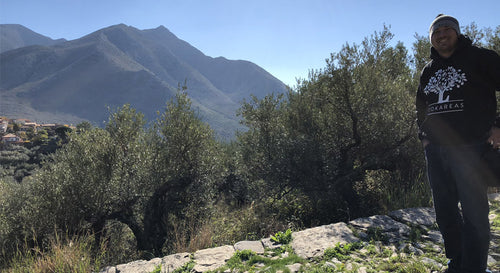History of the Olive Tree

The olive tree is one of the oldest known cultivated trees by mankind. Archaeological research and studies have found records of cultivating olive trees that go back over 6000 years, in the Mediterranean basin, and more specifically in the countries of Greece, Cyprus, Lebanon, Syria and Israel.
It is possible that ancient man discovered that olives could be cultivated when he cut olive branches to kindle a fire, or make a weapon. Then after time, it was revealed that the cut branches left partially covered on the ground, germinated into wild olive trees.
One of the first cultures to embrace the olive tree and discover it's amazing benefits was the ancient Greeks. According to legend, the olive tree was given to the ancient Greeks as a gift from the gods. Historians such as Herodotus documented this, and philosophers such as Aristotle elevated olive cultivation to a science. The ancient Greeks crowned the champions of the Olympic games with a crown made from a wild olive tree branch and a cup of wild olive oil.
Athens, the capitol city of Greece, according to Myth, was named after the Greek goddess Athena. The ancient myth states that when this newly found city (at that time names Kekrops) was formed, there was a dispute between Poseidon and Athena over whose name they would name the city after. The council of gods gave this victory to Athena because she offered the first gift to the city, a domestically-cultivated olive tree, planted at the Acropolis at the Erechtheion temple.
Just as the olive tree was a symbol for the Ancient Greeks, it was for the Ancient Romans as well. About 2500 years ago, the olive tree migrated through the Mediterranean basin to the Romans, likely from Ancient Greece. The Romans and Greeks developed all aspects of cultivation, production and processing. The Romans invented the Hydraulic screw press, which was the most common press used up until about 50 years ago, and we still use today in some of the traditional stone presses in our region.
In addition to the Greeks and the Romans, the olive tree has had great historical importance and has been documented this way by the Syrians, Egyptians, Israelites, Arabs, Babylonians and many others in ancient times.
The olive tree is a symbol in biblical history as well. In the story of Noah's ark, once all the waters of the flood has receded, Noah sent a dove out of the ark, and the dove returned carrying an olive branch, from that point on the olive branch has forever been recognized as a symbol of peace. Olive oil is used in many Christian ceremonies, specifically the Orthodox in wedding ceremonies and baptisms. Consecration of orthodox priests, and even the Kings of Greece was done with Olive Oil.

The olive tree immigrated to the Americas on or around 1800 AD, when seeds or cuttings were brought to San Diego by the Spanish settlers. Since then, more olive trees have been planted in the California region.
In conclusion, the olive tree is an amazing species with a history that surpasses the invention of written language, therefore, it is impossible to determine when the tree first came about. We have many archaeological facts and old writings that show that the cultivation of olive trees to make olive oil has been happening for at least 6000 years.
The origin of the domesticated olive tree most likely started in mainland Greece, Crete, the Aegean islands, or somewhere remotely close to that area, and then spread to the rest of the world.


